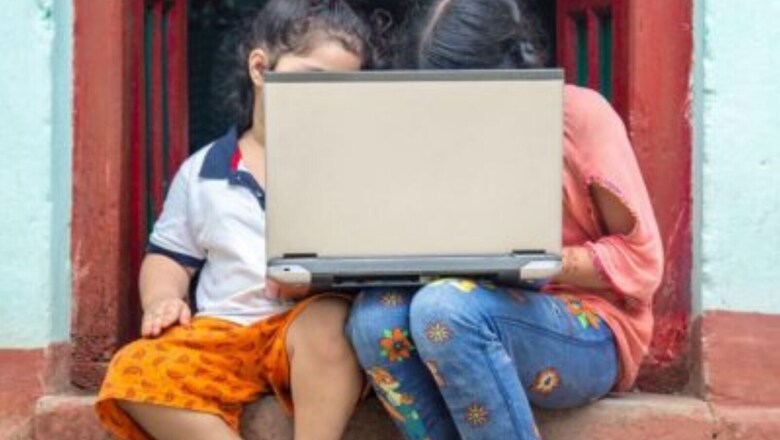
views
The Budget announcement every year by the Finance Minister is a big event typically followed by praise, criticism, expression of opinions by experts and conversation among people in general. Since it is essentially a financial statement documenting a record of revenue earned and expenditure envisaged by the government, the most obvious indicator of the government’s intent to work in any sector is the budgetary allocation earmarked for it.
Although I will briefly present the main features of Budget 2022 with respect to education, my focus is not to comment on the implications of budgetary allocation for different sectors within education. My attempt here is to present the state’s vision of education, the meaning envisaged, the educational gaps and the strategies identified to address them, as reflected in the Budget.
This year, the budgetary provision for education has increased by 11.86 per cent from the previous year. The sectors in education which have been allotted resources are: Department of School Education and Literacy, Department of Higher Education and Samagra Shiksha for creating exemplar schools which will offer quality education. Kendriya Vidyalaya Sangathan (KVS) and Navodaya Vidyalaya Samiti (NVS) have enhanced budgets too. As is known, KVS and NVS are special schools for children of central government employees and talented children from rural areas, respectively.
Besides the usual provisions, a Digital University has been proposed to give access to world-class quality education to all students with personalised learning experience at their doorstep. There is an assumption that being digital equals world-class with the potential of offering personalised learning experience. Needless to say, this needs to be examined. Setting up 750 virtual labs in Science and Maths has also been proposed, to promote crucial critical thinking skills among children. Improvement of digital infrastructure in rural areas is planned under which DTH access will be provided to Doordarshan and educational channels for villages in the northern areas.
The Budget also focuses on skill development and vocational education; development of content and its availability through different media like online, television and radio; PM e-Vidya programme to be extended from 12 to 200 TV channels; teachers to be trained to teach with digital tools and setting up world-class foreign universities in Gandhinagar, free from domestic regulations, to facilitate skill development in the financial services space.
The education budget, however, also exhibits some glaring gaps as reported in India today. Like the budget for education has increased in absolute terms, but public investment in education is nowhere near 6 per cent of GDP as stipulated by National Education Policy 2020. The Samagra Shiksha scheme – which saw a big reduction last year – could not make up for the previous year’s budget despite increased allocation this year. Among the sectors which have seen a reduced or similar allocation as last year are teacher training, adult education, scholarship for ST girls from rural areas and mid-day meal scheme.
There is no denying that the Budget reflects government’s priorities, and overall intent. Though the financial requirements form an integral and basic variable for growth of any sector, there is no direct correlation between greater finances and greater good for the sector and people benefitted by it.
Somehow the steps taken over the past two years, including measures adopted to make up for school closure and loss of learning, and desperation to find alternative ways of assessing students reminds me of a quote from the famous Yashpal committee report on Learning without Burden, which said: “a lot is being taught but little is learnt or understood”. This means that though it seems a lot of work is being done in schools – could be as banal as copying from textbook to blackboard, from blackboard to notebooks, assigning homework and conducting examinations – one is not sure whether any learning is taking place and what that learning really means. Similarly, every year lots of schemes and programmes are initiated but what difference do they make to providing equitable, uniform and quality education to all irrespective of where they come from, is a question which remains largely unanswered.
The general character of school education in our country is alienating. The colonial system of education delegitimised the local knowledge, culture and language and instead imposed western model of knowledge and culture. This impacted the pedagogic transactions in class as they had to be done in English, which neither the teacher nor the student had any idea of. In the entire lockdown period, the main concern of schools continued to be transacting of the curriculum in a new language which was ICT (information and communication technology) dependent. Another cause of anxiety was the pressure to conduct exams. Nobody was concerned with the fears and anxiety that children may have been grappling with or how to make education more relevant to the contemporary context of students’ lives and concerns.
The pandemic changed the lives of so many people but the education system continued with its earlier understanding of education, equating information with knowledge. Similarly, if one sees the semantics of the Budget, one can see use of words like access and delivery. Which means that we are equating education with making some information available to the students, delivered to them in a unilinear manner where the student has little agency. The online platform did come in handy during COVID-19 when schools were physically closed but mistaking online teaching as a better alternative would be fatal to the future and dreams and aspirations of so many students who wish to move up the social ladder.
The focus on creating islands of excellence or exemplar schools does not make sense in a country which should now be moving towards providing uniform quality education to everybody. A few model schools, KVs, NVs will always benefit a minuscule proportion of the population. Rather than creating layers in a divided education system which caters to the differential needs of different socio-economic groups, one should stop this obsession of catering to the needs of a small privileged minority.
The focus of the Budget seems to be digitising education and offering more such options to children. Neither is education information nor are children empty vessels to be filled up with information. Research has shown the chaos which digital divide created in the lives of children. We cannot look at digital education as a substitute, a stopgap arrangement or even as complementing offline education. Excessive focus on digital education could be fatal in a country whose education system is already divided in consonance with its divided social fabric.
The author is Professor and Dean, School of Education, Tata Institute of Social Sciences, Mumbai. The views expressed in this article are those of the author and do not represent the stand of this publication.
Read all the Latest Opinions here

















Comments
0 comment